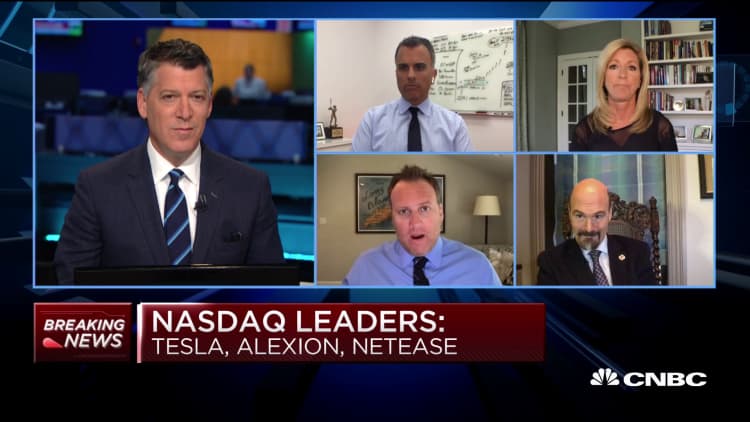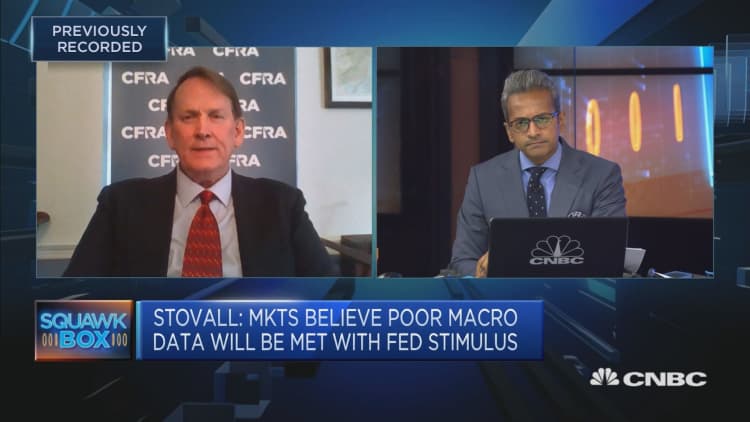Even with a reduction in employee head count that likely has exceeded 30 million, companies still face profit pressure in an economy that will be dramatically retooled by the coronavirus.
While businesses save money on payrolls, they'll still see anemic demand, prices falling at a record pace and a myriad of other obstacles centering on how they will reopen once they finally can come back online.
Stocks, though, are rallying in the face of historically awful economic numbers, in a bet on higher profit margins and an aggressive recovery that seems increasingly risky.
"This big rally we've seen in equities, the fundamentals on which it is based seem pretty shaky," said James Knightley, chief international economist at ING. "In terms of the U.S. specifically, you're going to have the social distancing story remaining for months and months. The consumer anxiety is likely to remain with us for months and months. Travel restrictions are going to remain in place. The legacy of 35 to 40 million Americans out of work, to me that is not a particularly strong environment for getting good earnings growth."
Indeed, for the first quarter, with 86% of S&P 500 companies reporting, earnings are on track to fall 13.6%, according to FactSet. That would be the worst quarter in nearly 11 years, and the news is only going to get more dismal. Forecasts for the rest of the year see a 40.6% drop in Q2, a 23% decline in Q3 and 11.4% in Q4 for an index that currently is trading at a gaudy 20.4 times forward earnings, the richest level in 18 years.
That also comes against a backdrop of a 14.7% jobless rate and at least 20.5 million jobs lost in April, according to Labor Department numbers that are the worst since the Great Depression and almost surely understate the employment plunge. On top of that, the core consumer price index saw its biggest one-month drop in history for data going back to 1957, indicating that business have little pricing power.
Challenges ahead
Still, the market has been in rally mode since late March, when the Federal Reserve pledged a bond-buying program that would continue until the economy got back on its feet. The S&P 500 is up about 30% since its March 23 low amid a flurry of fiscal and monetary support that is overpowering the prospect of a grudging recovery.
"The massive decline in demand means that there is this inventory overhang," Knightley said. "That means price cuts coming through. Profit margins are going to remain under pressure. Then again, you're looking for companies that are desperate for cash, so they might not care about profits now. They're just going to be desperate for cash."
First-quarter S&P 500 profit margins are about 9.5%, down from 11% a year ago but still fairly healthy.
Going forward, though, corporate officers will have much to ponder when evaluating their prospects. Paramount will be not only how soon the economy can restart but also what happens ahead if another coronavirus wave hits later in the year.

They also have political considerations: the presidential election in November and the power structure in Congress hanging in the balance.
"That's the dilemma for the policymakers, it's the dilemma for the economy. It's a quandary, because right it's the uncertainty that still permeates the ability to offer guidance," said Quincy Krosby, chief market strategist at Prudential Financial. "CEOs and CFOs are working on the various scenarios, and those scenarios include layoffs if the economy doesn't regain momentum by the end of the year."
Permanent or temporary?
April's jobs report indicated that about 80% of the positions lost were furloughs, meaning temporary rather than permanent reductions. However, the longer the shutdown continues and the deeper the dive in consumer and business confidence, the harder it will be justify bringing back those cut.
Recent research from the University of Chicago estimated that 42% of the recent layoffs will be permanent due in part to "a sharp pandemic-induced rise in equity return dispersion across firms."
The layoffs, and their bottom-line impact, likely will be sector-specific, said Art Hogan, chief market strategist at National Holdings.
"We contemplate all these sorts of inputs a lot as they're now affected by the way we're all working from home. It's largely dependent on your sector," he said. "If we think we can operate at the capacity we operated at before Covid-19 with fewer people, that's a positive for margins. I just don't what know what the calculations are that go in there."
One input will be real estate — as retained employees move to permanent work-from-home positions, there won't be as much space needed to house them. At the same time, companies looking to maintain safe social distancing won't be able to pack workers together as tightly.

Technology also will be a major consideration, with companies moving toward finding ways to do more with automation. However, companies that stick with mass layoffs also risk damage to their brand, said Robert Teeter, head of the investment policy and strategy group at Silvercrest Asset Management.
Teeter sees the stock market rally now being supported primarily by firms that have been able to continue operations through the crisis and actually have been able to maintain payroll. Overall, he considers the longer-term outlook for the market as "favorable" and remains "cautiously optimistic."
"Some areas of the economy are likely permanently impaired, where demand is almost completely wiped out and these workforces are among those that will likely shift from temporary [layoffs] to permanent," he said. "While this may cause some creative destruction, it may also sadly cause others to fail that were otherwise OK."



